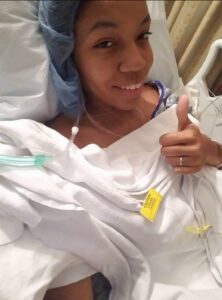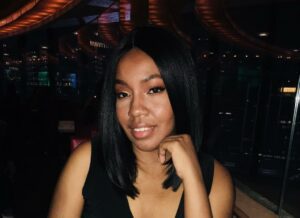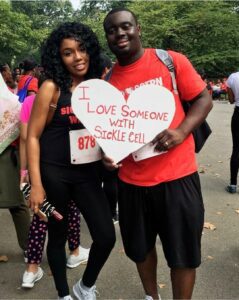By: Malika Abrams
I was eight years old when I found out that I was sick. After spending a beautiful summer day at the community pool with my parents, brothers, and cousin, I developed intense pain in my legs that got worse by the minute during our drive home. When my parents brought me to the hospital to be admitted, they told me that I had sickle cell disease (SCD) and that the pain I was feeling was known as a “sickle cell pain crisis.” I was terrified and confused.
I would later learn that SCD is a rare genetic disease that causes the red blood cells to form a sickle shape, affecting their ability to transport oxygen in the blood efficiently. People living with SCD can experience many complications as a result, including severe pain, anemia, infections, heart disease, stroke, liver disease, pulmonary hypertension, and liver failure. There is a common misconception that SCD only occurs in people of African descent, but it can also affect people of Hispanic, Middle Eastern, Mediterranean, Indian, and Asian heritage.
I coped with my first hospitalization by adapting a “go with the flow” mentality. I took pain medications, ate the
In 2013, a trip to New Mexico to visit my mother completely changed the course of my life. The day after I arrived, I began feeling sick and my legs started to hurt. I went to the local emergency room because my condition quickly deteriorated. I went from walking around the house to being unable to stand within minutes. The emergency room doctors were not experienced in treating people with SCD, and so my family decided I should be flown home to New York to my own doctors.
When I eventually arrived in New York, I learned that I had acute chest syndrome, which is one of the deadliest complications that someone living with SCD can experience. I am grateful that I was able to recover with the help of multiple blood transfusions during my month-long hospital stay.

After experiencing these complications, I knew I needed to take more time to learn about SCD and what I could do to maintain my health. I began making sure that I drank plenty of water, ate healthy foods, and exercised regularly. I also accepted that living with SCD meant needing help from my family and my husband. I joined support groups on Facebook, made friends with others living with the condition, and began attending SCD research benefit events. I enrolled in college and joined the Differently Abled Students Administration so that I could raise awareness of conditions like SCD. I earned my bachelor’s degree in biology this year and I am preparing to attend school to become a physician’s assistant so I can make a positive difference in the medical community.
I hope that sharing my experience helps more people learn about SCD and inspires other people living with this disease to share their stories. I want my fellow sickle cell warriors to know that while SCD can be challenging, it should not hold them back from achieving their goals. I also want them to know that they are not alone in their fight. SCD brings both physical and emotional challenges and it is important for SCD warriors to know that there are support groups, therapists, and friends who can help them get through the hard times.
I am encouraged by research that is underway to identify treatments that are more than band-aids for our symptoms. I am hopeful that there will soon be a treatment option that addresses the genetic cause of sickle cell. I dream that one day I will be able to take a pill every morning to keep me free from the SCD symptoms that previously weighed me down. Until that time comes, I will continue to share my story with anyone who will listen. I want the world to know how strong a warrior I am.








